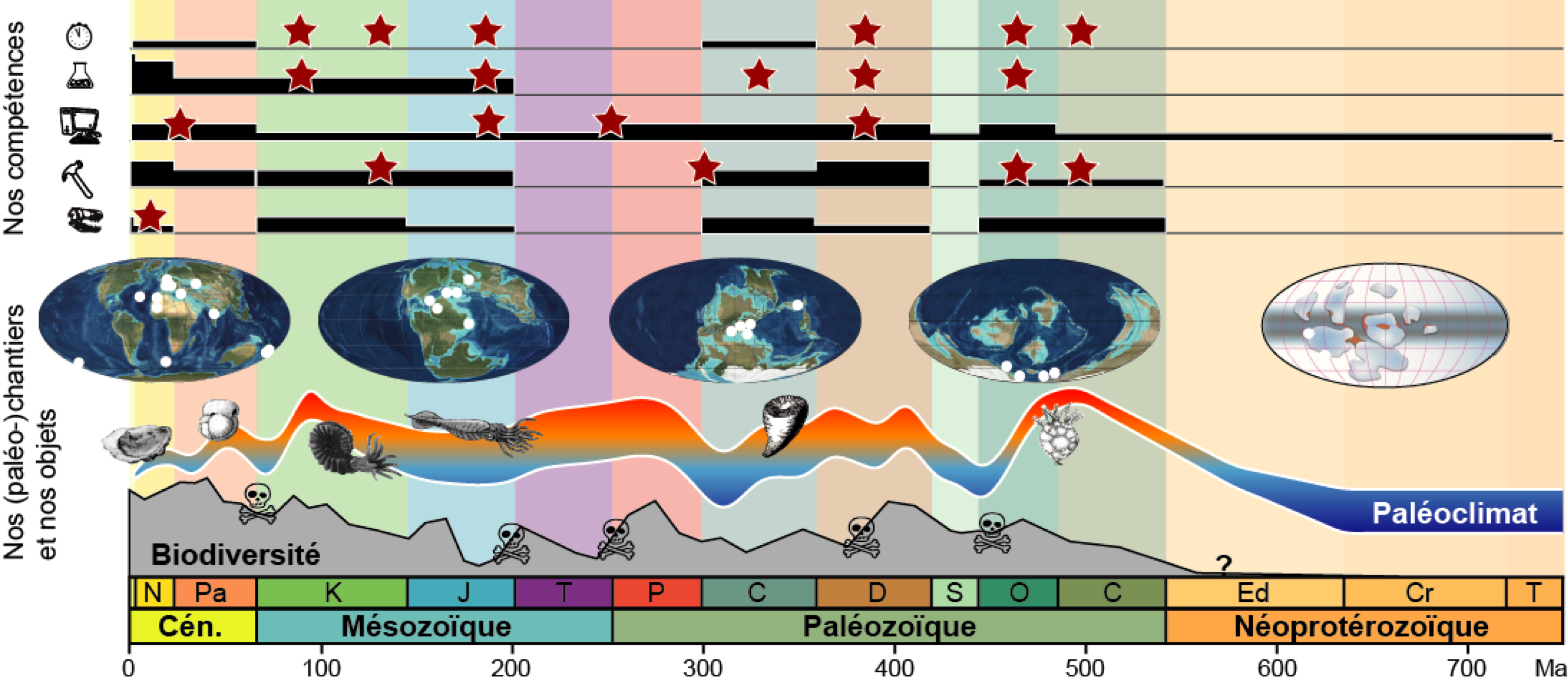The PALEO working group reconstructs paleoenvironments and explores their spatio-temporal diversities, using various methods, objects and proxies (fossils, sediments, organic matter, geochemical and isotopic tracers, numerical modelling) applied to different periods of the Earth’s history
Participants: E. Nardin (coord.), M. Aretz, V. Chavagnac, G. Dera, Y. Goddéris, C. Lézin, V. Luccisano, M. de Rafélis, G. Caravaca, D. Chardon, F. Christophoul, Y. Denèle, A. Maillard, D. Rouby.

The PALEO projects explore the dynamics of the Earth’s outer envelope (atmosphere-ocean-biosphere) on geological time scales using multidisciplinary approaches involving paleontology, geochemistry, sedimentology, stratigraphy and numerical modeling. The complementarity of our approaches allows us to address not only factual reconstructions of environments, biodiversities and geographies, but also to identify the underlying natural processes over the last 800 million years of Earth’s history.
Axis 1: Geographies and temporal calibrations of the sedimentary architecture of basins
The study of the evolution of surface envelopes requires a very detailed knowledge of time, both in age and duration. We face the difficulties of stratigraphically correlating several spatial observations at different scales, and of constraining the elapsed time that is recorded or not in the sediments.
We temporally calibrate the sedimentary architecture, based on bio-, chemo- and cyclo-stratigraphy data. This temporal framework allows exploration of the kinetics of geological (e.g., continental and oceanic weathering, subsidence, sedimentation rates) and biological (e.g., evolutionary rates, migration rates) processes in the Paleozoic, Mesozoic and Paleogene.
Our expertise extends to the reconstruction of local to regional paleogeographies based on the spatialization of continental and marine paleoenvironments, relative sea level evolution and tectonic modeling of basin sedimentary architectures in orogenic and anorogenic contexts.
Finally, our projects are anchored on time and space readings (regional to global scales), which are two fundamental elements for understanding the history of the Earth system’s outer shells and their dynamics. Data compilation and spatialization is intrinsic to regional environmental reconstructions and regional to global paleogeographic reconstructions. These projects contribute to the calibration of geological time. They lead to stratigraphic correlations that are useful to better understand processes at regional to global scales.
Axis 2: Sedimentary record of climate and ocean dynamics
The understanding of bio-geochemical cycles allows us to explore the climatic and geodynamic feedbacks through the permanent exchange of elements and energies between the different surface envelopes of the Earth.
The oceans and their sedimentary covers archive past climatic, biological and hydrogeochemical conditions. The general understanding of the oceanic system and climate feedbacks leads us to focus on the mechanisms and constraints of system disturbances. We study the records and causes of major Phanerozoic climatic and oceanographic upheavals by exploring current and past spatial heterogeneities in biological and environmental signals and their responses to perturbations. Our approaches couple sedimentology, paleoecology, sedimentary, isotopic and organic geochemistry, and numerical modeling. This approach constrains the links between carbon cycle, oceanic anoxic events, climatic and geodynamic perturbations, and will allow to discriminate between local and global forcings. We are working to calibrate some markers of ocean circulation, salinity, continental weathering, and water mass oxygenation (REE, Sr, Nd), and to re-evaluate their ocean residence time.
Studies of the temporal and spatial evolution of the chemical state of the oceans and atmosphere (in direct contact) must integrate the reconstruction of continental inputs (continent-ocean interface) and hydrothermal inputs (lithosphere-ocean interface) on the elemental chemistry and isotopic systems (Sr, Nd, O, C, Li) of oceanic waters and sediments, both for platform environments and for deep basins.
Understanding global ocean biogeochemical cycles allows us to distinguish the relative impact of hydrothermal or fluvial fluxes, to discriminate between inputs from physical erosion or chemical alteration of the continents, and to reassess the role of biomineralization on past ocean chemistry. We quantify the latitudinal variability of past and modern ocean chemistry. We reconstruct the extension of climate zones into greenhouse and icehouse periods and climate seasonality in the Cenozoic. We continue our work in modern times via the development of new geochemical/isotopic tracers (Li, Cr), numerical model couplings and in-situ monitoring instrumentation.
Axis 3: From evolutionary paleobiology to ecosystems
Ecosystems include biological communities and their links (active or passive) with the environment, through the availability of nutrients, or the carbon cycle. A first step is to discriminate intrinsic factors from abiotic factors acting on organisms and communities, in order to study their links with external processes.
Our analysis of the dynamics of each ecosystem crisis is based on the acquisition of paleontological and sedimentary field data integrated at the regional and global scales. It allows us to describe the evolutionary, migratory or paleoecological history of echinoderms, corals, cephalopods and foraminifera, during periods of stability or crisis. We examine the ecological tolerances of certain taxa (through fossil geochemistry) and numerical modeling of physico-chemical constraints.
We characterize the evolution of biological forms over time, and quantify the magnitudes and temporalities of biological crises. We address questions of biological (e.g., taxa, morphologies, behaviors) and/or ecological (e.g., biome food web stability) selectivity of extinctions for targeted Phanerozoic periods.
Our second objective concerns the interactions between abiotic components of global geochemical cycles and the structuring of past marine ecosystems, through numerical modeling and naturalistic studies of past and present biodiversity. A major issue is the incorporation of biological complexity in coupled numerical models of climate/geochemical cycles to study the intrinsic behavior of living organisms during crises, the local couplings between biotic/abiotic processes and the feedbacks of living organisms on the functioning of the Earth system.
